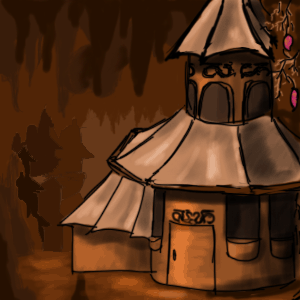Korvarrin architecture typically comes in two flavours: the flat style, and the tall style. Although as with many things, there are other styles and fusions of styles that exist.
Flat Style
Also known as the slum style, this simple style is characterised as a cuboid shape, with flat walls and mostly flat, gently sloping roofs, with anywhere between one to four floors. As a style developed on the hot surface, the roofs have barriers with small gutters at the corners. This allows rain water to accumulate on the roofs and slowly run off, cooling down the building below.
The windows are typically unadorned from the outside, occasionally they will sport thin slats that curve out and away from the window, redirecting the rainwater away from the window opening. Flat, smooth walls with hardly any form of protruding ornamentation means nothing gets blown off or torn down when the worst of the desert winds hit.
The walls are usually made of mud, and occasionally surrounding plants will grow up and into the walls. This is usually allowed as plants help further cool the house and, if they flower, can provide food in the form of fruits, although people might choose to uproot them if the roots threaten to break the integrity of the walls. A small step is always built under the door, elevating the entrance slightly above ground, to prevent flooding during the rainy season.
This style is also known as the slum style as it was imported to the underground by surface-dwellers moving underground in a second wave of ‘immigration’. This second wave was larger than the first, and many settled in extremely crowded communes. The poverty and desperation of these communes became associated with the architecture, and even if many buildings in the underground now use the flat style, the nickname of ‘slum’ style has stuck till this day.

Tall Style
The tall style was a style that is said to date back to the Time of the Old Sea, where it was employed widely on the surface. For the reason it has earned the alternate moniker of ‘old’ style. The older, grander, and more spacious parts of the underground are filled with buildings in this style.
With sharp, steeply sloping, concave roofs, this style is designed to let water run off as swiftly and easily as possible. Although it doesn’t rain underground, the earth absorbs the massive amounts of rain water that falls on the surface during the rainy season and empties itself out slowly over time into the underground below as dripping water. Roofs on lower levels are also usually equipped with a gently sloping gutter running along the outer edge which helps channel away water to the drainage system.
This style is tall, skinny, and round, and range anywhere between two to seven floors tall. The reason why the taller buildings can support so much weight is because they are typically built into the side of the underground caverns, sometimes from the very same mud and earth, making distinguishing the natural mud walls from the constructed earthen walls of the building from the outside an impossible task. Round arched windows and doorways littering the walls also serve to lighten the walls and support the upper levels.
Some of the newer buildings in the old sections of the underground show fusions between the tall and flat styles, where side rooms and storage spaces have adopted the flat style’s boxy shape, or have circular rooms with flat roofs.
Most Korvarrin buildings are adorned with icons of the High Ones, usually in the form of painting or relief carving. Even if the inhabitants of the buildings themselves are not Dracoists, the builders might have been, or the architects, or maybe they just accepted it as a part of Korvarrin visual culture. Two dragons facing each other is usually a depiction of Korthet and Varros, a single dragon with large twisting horns is Venya, and a single dragon with six wavy horns is Tod. The depictions can be extremely elaborate, with individual scales meticulously detailed, though just as often, the icons are simplified to the point where they are a simple series of abstract swirls.
